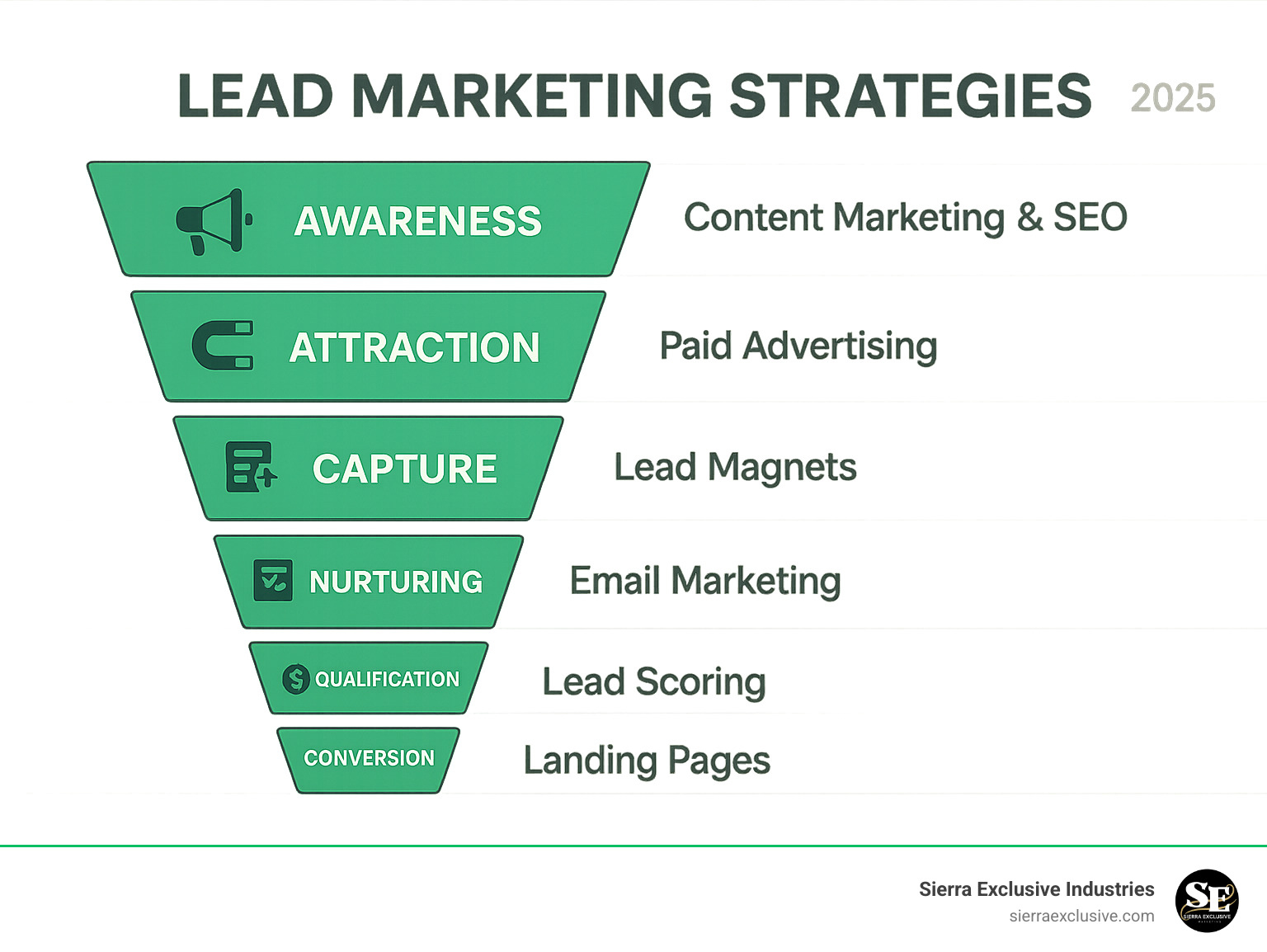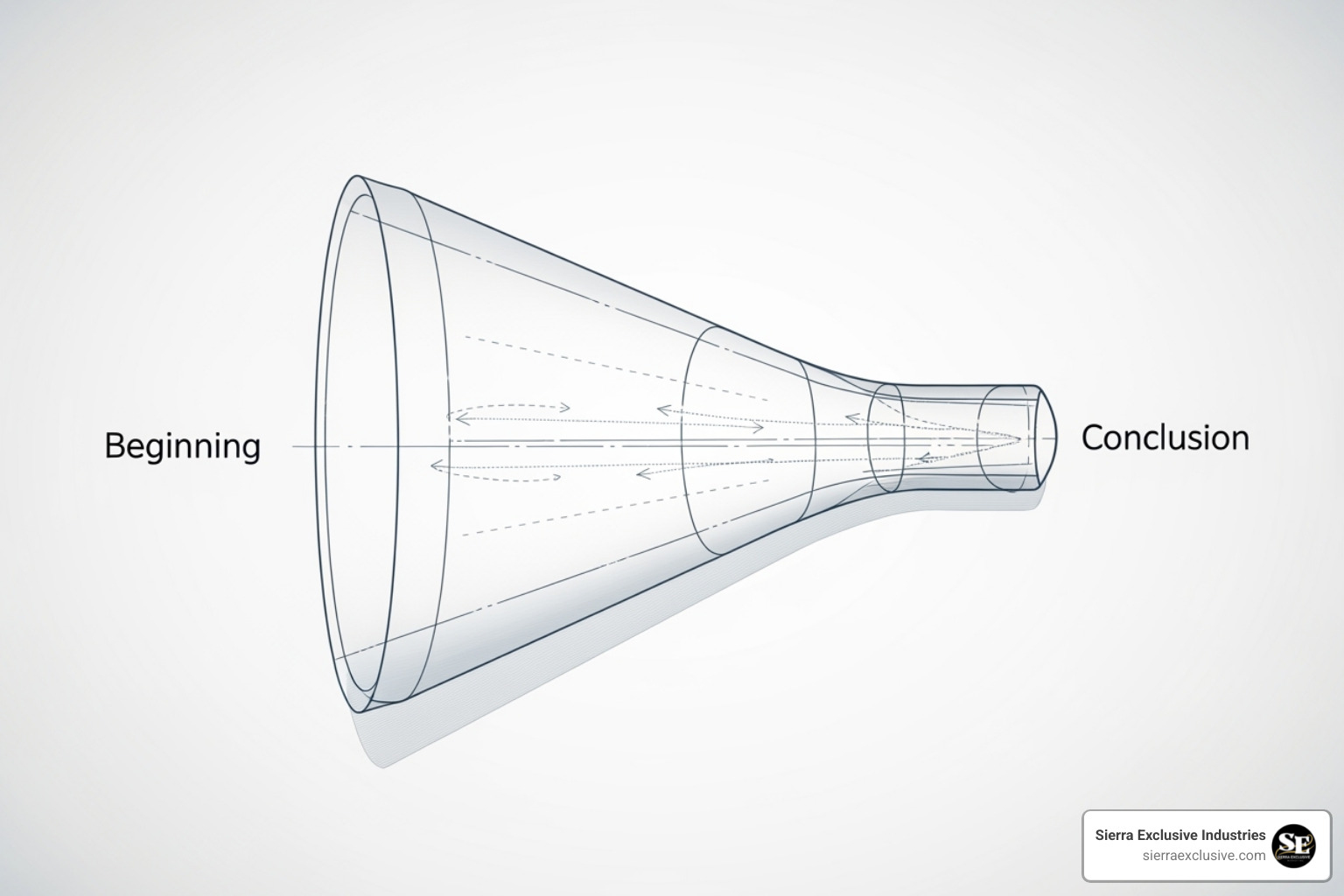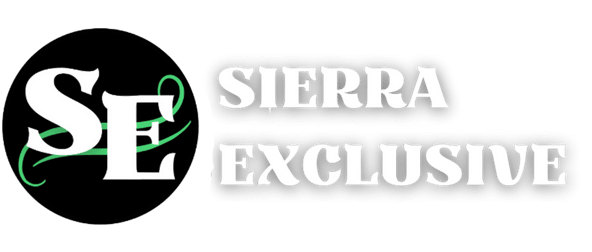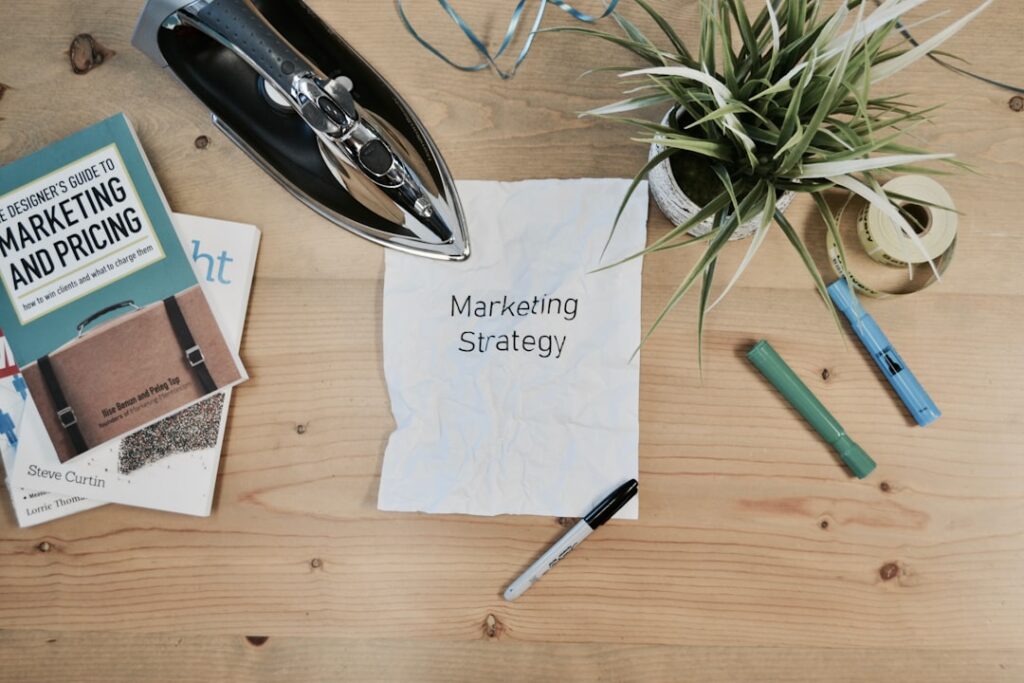Why Lead Marketing Strategies Drive Business Growth
Lead marketing strategies are the lifeblood of any growing business, helping you attract potential customers and guide them toward a purchase. With 6 in 10 marketers prioritizing lead generation, a strong strategy directly impacts your bottom line. The key is focusing on quality over quantity—attracting better leads who are more likely to become loyal customers.
Effective strategies range from Content Marketing and SEO to Paid Advertising, Social Media, and Email Marketing. This guide covers the foundational concepts, proven tactics, and optimization tips you need to build a lead generation system that delivers sustainable growth.

Lead marketing strategies further reading:
Understanding the Foundations of Lead Marketing Strategies
Before diving into specific tactics, let’s cover the core concepts that make every lead marketing strategies campaign more effective.
What is a Lead and Why is Generation Vital for Growth?
A lead is anyone who has shown interest in your business, whether by downloading a guide, signing up for a newsletter, or browsing your pricing page. This is the foundation of inbound marketing—attracting customers by creating valuable content and experiences.
Instead of cold-calling strangers, you’re having conversations with people who want to hear from you. This approach, prioritized by 6 in 10 marketers, leads to consistent customer acquisition, stronger audience relationships, and more predictable revenue growth. For a deeper dive, see our guide on What is Lead Generation in Digital Marketing?
The Modern Lead Funnel: From Prospect to Customer
The lead generation process is often visualized as a funnel, guiding a stranger to become a customer. Each stage requires a different approach.

- Top of the Funnel (TOFU): In the awareness stage, people have a problem but may not know you exist. Your goal is to be helpful with blog posts, infographics, and educational videos.
- Middle of the Funnel (MOFU): In the consideration stage, prospects are evaluating solutions. Use case studies, webinars, and detailed guides to showcase your expertise.
- Bottom of the Funnel (BOFU): In the decision stage, prospects are ready to buy. Offer free trials, demos, and consultations to make their choice easy.
Content mapping is the art of matching your content to the prospect’s stage in this journey.
How to Qualify Leads: MQL vs. SQL vs. PQL
Not all leads are equal. Qualifying them helps you focus on prospects who are most likely to convert.
- Marketing Qualified Leads (MQLs) have shown significant interest (e.g., downloaded multiple resources) but aren’t ready for a sales call. Marketing continues to nurture them.
- Sales Qualified Leads (SQLs) have indicated they’re ready to talk business, perhaps by requesting a demo or quote. These are passed to the sales team.
- Product Qualified Leads (PQLs), common in SaaS, have used a free trial or freemium product and shown signs of being ready to upgrade.
Lead scoring automates this process by assigning points to user actions. Many sales teams also use the BANT framework (Budget, Authority, Need, Timing) to qualify leads. Proper qualification ensures your sales team spends time on the most promising opportunities. Learn more in our Lead Qualify guide.
Why You Should Generate Leads Organically (Not Buy Them)
Buying a list of leads is a tempting shortcut, but it’s one that often fails. Bought leads don’t know or trust you, and the lists are often outdated and of poor quality. This approach can damage your email deliverability if recipients mark your messages as spam.
Organic lead generation builds relationships with people who want to hear from you. These leads convert at higher rates, become better customers, and refer others. It’s a long-term strategy that builds a valuable asset for your business, delivering a much higher ROI over time than constantly buying new lists.
Core Digital Lead Marketing Strategies
Here are the most effective channels for attracting high-quality leads online.
Using Search Engines with SEO and Content Marketing
With 8.5 billion daily Google searches, your customers are actively looking for solutions online. SEO and content marketing are powerful lead marketing strategies that meet people at the exact moment of need.
Effective SEO starts with keyword research to understand your audience’s language and is supported by a fast, mobile-friendly website. Content marketing works with SEO to build trust by providing valuable blog posts, guides, and videos that address customer pain points. For local businesses, local SEO is crucial for capturing “near me” searches. Unlike paid ads, great content creates compounding returns, attracting leads for months or years.
Ready to harness the power of search? Explore our SEO Lead Generation services, and don’t miss our insights on Local SEO for Contractors: Nail Your Online Presence.
Accelerating Growth with Paid Advertising Campaigns
When you need results now, paid advertising delivers. Pay-per-click (PPC) campaigns on platforms like Google Ads and Meta Ads offer immediate visibility and precise targeting.

- Google Ads captures high-intent users who are actively searching for your products or services.
- Meta Ads (Facebook & Instagram) create demand by targeting users based on their interests, demographics, and behaviors.
Retargeting is especially powerful, showing ads to previous website visitors and converting them at much higher rates. Lookalike audiences help you find new prospects who share characteristics with your best customers. Continuous A/B testing of ad elements ensures you’re always optimizing for better results.
For expert campaign management, check out our Google Ads Management and Meta Ads services.
Social media lead marketing strategies that work
Social media is where marketers build relationships and generate leads. Success comes from creating genuine connections, not just posting content. Community building, responding to comments, and engaging in conversations are key.
Short-form video on platforms like TikTok, Instagram Reels, and YouTube Shorts is highly effective for showcasing personality and sharing quick, valuable tips. To choose the right platform, consider your audience:
- B2B (Business-to-Business): LinkedIn is the dominant platform for reaching professional decision-makers.
- B2C (Business-to-Consumer): Facebook and Instagram offer sophisticated targeting to reach consumers based on interests and behaviors.
- Younger Audiences: TikTok and Instagram are ideal for capturing attention with creative, entertaining content.
Learn more in our Social Media Marketing Strategies guide.
Nurturing Prospects with Personalized Email Marketing
Email marketing remains a top-performing channel, delivering an average 122% ROI. The key to success is personalization and relevance.
Smart segmentation allows you to divide your list based on user behavior and send highly targeted messages. Marketing automation handles the heavy lifting, sending welcome series or follow-up emails based on triggers you set. These automated drip campaigns guide prospects through your funnel with valuable content over time. Remember to provide value in every email to build trust before you ask for the sale.
Ready to transform your email marketing? Dive into our comprehensive guide on Email Marketing Best Practices for Increased Engagement.
Advanced Lead Marketing Strategies to Amplify Your Results
Go beyond the basics with these cutting-edge techniques to gain a competitive advantage.
Leveraging AI and Automation for Hyper-Efficiency
Artificial intelligence and automation are changing lead marketing strategies. These tools offer practical ways to generate and nurture leads with incredible efficiency.
- AI Chatbots can greet website visitors 24/7, answer common questions, and qualify leads without human intervention.
- Predictive lead scoring uses AI to analyze data and identify which prospects are most likely to convert, helping your sales team prioritize their efforts.
- AI-powered tools can assist with content creation, speeding up the process of drafting blog topics, emails, and ad copy.
- Personalized user experiences can be delivered in real-time, as AI algorithms serve up custom content and offers based on visitor behavior.
To explore how AI can revolutionize your marketing approach, check out our insights on AI Marketing Agency and Chatbots. For a broader perspective on the future of marketing technology, dive into AI-Powered Marketing: Opening the Next Era of Intelligent Advertising.
Captivating Audiences with Rich Media and Interactive Content
In a crowded digital space, static content is no longer enough. Rich, interactive experiences engage audiences and create memorable connections.
Video marketing is dominant, with platforms like YouTube serving as a primary search engine for many users. Product demos, testimonials, and how-to guides build trust in ways text cannot. Webinars and virtual events position you as an expert and generate highly qualified leads.
Interactive content like quizzes, calculators, and polls creates a two-way conversation, providing immediate value to users while collecting valuable data for you. A retirement calculator or a “What’s your workout style?” quiz are great examples of lead generation tools. Dive deeper into creating compelling visual experiences with our guide on Rich Media Marketing.
The Power of Human Connection: Networking and Referrals
Despite digital tools, the most powerful lead generation often comes down to human connection.
Professional networking at industry events (both virtual and in-person) remains a goldmine for quality leads. Business partnerships and co-marketing with non-competing companies multiply your reach by tapping into their audience and credibility.
Referral programs harness the power of word-of-mouth. A recommendation from a trusted peer is incredibly persuasive. When you consistently deliver exceptional service, happy customers become your best advocates, driving organic growth through priceless, trust-based promotion.
Optimizing Your Lead Marketing Campaigns for Maximum Conversion
Attracting leads is only half the battle. This section covers how to ensure they convert into customers.
Designing High-Converting Landing Pages and Forms
Your landing page is your digital salesperson, focused on one goal: turning a visitor into a lead. This is one of the most critical lead marketing strategies for success.
For a high-converting page, ensure you have:
- A Clear Value Proposition: Visitors should instantly understand what you’re offering and why it matters.
- A Compelling Call-to-Action (CTA): Use action-oriented language (“Get Your Free Guide”) and make the button stand out. Personalized CTAs convert over 200% better.
- Minimal Form Fields: Only ask for essential information, like a name and email. More fields create friction and reduce conversions.
- Mobile-First Design: With over half of traffic coming from mobile, your page must be fast and easy to use on small screens.
- Social Proof: Use testimonials, reviews, or client logos to build credibility and trust.
Always be A/B testing different elements to improve performance. You can also use a virtual heatmap tool to see how users interact with your page and identify optimization opportunities. For more, see our guide on Traffic Conversion Optimization.
The Secret to Effective Lead Marketing Strategies: Aligning Sales and Marketing
Even the best marketing falls flat if sales and marketing teams aren’t working together. When these teams are aligned, lead quality improves, and revenue grows.

Key components of alignment include:
- A Service Level Agreement (SLA): A formal agreement defining what marketing will deliver (e.g., number of qualified leads) and how sales will follow up.
- Shared Data via CRM: A central CRM gives both teams a complete view of a lead’s history, ensuring a seamless handoff and coordinated communication.
- A Consistent Feedback Loop: Sales provides insights on lead quality and customer pain points back to marketing, which helps refine campaigns. Marketing shares data on which content is performing best.
When sales and marketing work as a unified team, companies see customer retention increase by as much as 36%.
Frequently Asked Questions about Lead Marketing Strategies
What are the most common mistakes in lead marketing strategies?
Many well-intentioned businesses make avoidable mistakes. The most common pitfalls include:
- Buying Lead Lists: This damages trust and email reputation with low-quality, unsolicited contacts.
- Inconsistent Follow-Up: Speed is critical. Letting a warm lead go cold is a huge missed opportunity.
- Not Tracking Metrics: You can’t optimize what you don’t measure. Track conversion rates, cost per lead, and lead quality to make data-driven decisions.
- Misaligned Sales and Marketing: When teams work in silos, leads fall through the cracks.
- Ignoring Mobile Users: With over half of web traffic on mobile, a poor mobile experience is a conversion killer.
- Vague Calls-to-Action (CTAs): Be specific and action-oriented. Tell users exactly what to do and what they’ll get.
How long does it take to see results from lead marketing strategies?
The timeline depends on the channel.
- Paid Ads (PPC & Social): These can generate leads within days or weeks, offering immediate results for your investment.
- SEO & Content Marketing: This is a long-term play. It typically takes 6-12 months to see significant lead generation, but the results are sustainable and high-quality.
- Email Marketing: If you have an existing list, you can see results immediately. Building and nurturing a new list is an ongoing process.
- Referral Programs: These can deliver results surprisingly fast, sometimes driving significant new business within six months.
How do I measure the quality of a lead?
Focusing on quality over quantity is key. Use these methods to measure it:
- Lead Scoring: Assign points to leads based on their demographics and actions (e.g., visiting the pricing page).
- Conversion Rate to Customer: The ultimate metric. Track which lead sources produce the most paying customers.
- Customer Lifetime Value (CLV): High-quality leads often become customers who spend more over time.
- Sales Team Feedback: Your sales team has direct insight into which leads are genuinely interested and a good fit.
- Fit with Ideal Customer Profile (ICP): The best leads closely match your definition of a perfect customer.
Conclusion
Mastering lead marketing strategies is an ongoing journey of testing, learning, and adapting. The most successful approach is multi-channel, where strategies like SEO, content, social media, and email marketing work together to create a result greater than the sum of its parts.
By focusing on organic lead generation and providing genuine value, you build a sustainable engine for growth. Quality will always trump quantity; a handful of well-qualified prospects is far more valuable than hundreds of uninterested contacts. As technologies like AI and automation become more accessible, businesses of all sizes can deliver the personalized experiences that build lasting relationships.
The key is to stay curious, measure your results, and continuously refine your approach to cast the right net in the right waters.
For expert guidance in building a powerful lead generation engine custom to your business goals, explore our SEO services. At Sierra Exclusive Industries, we partner with businesses to scale from their first $1 million in ARR up to $10 million, using a proven, data-driven framework to generate better leads and drive sustainable growth.




